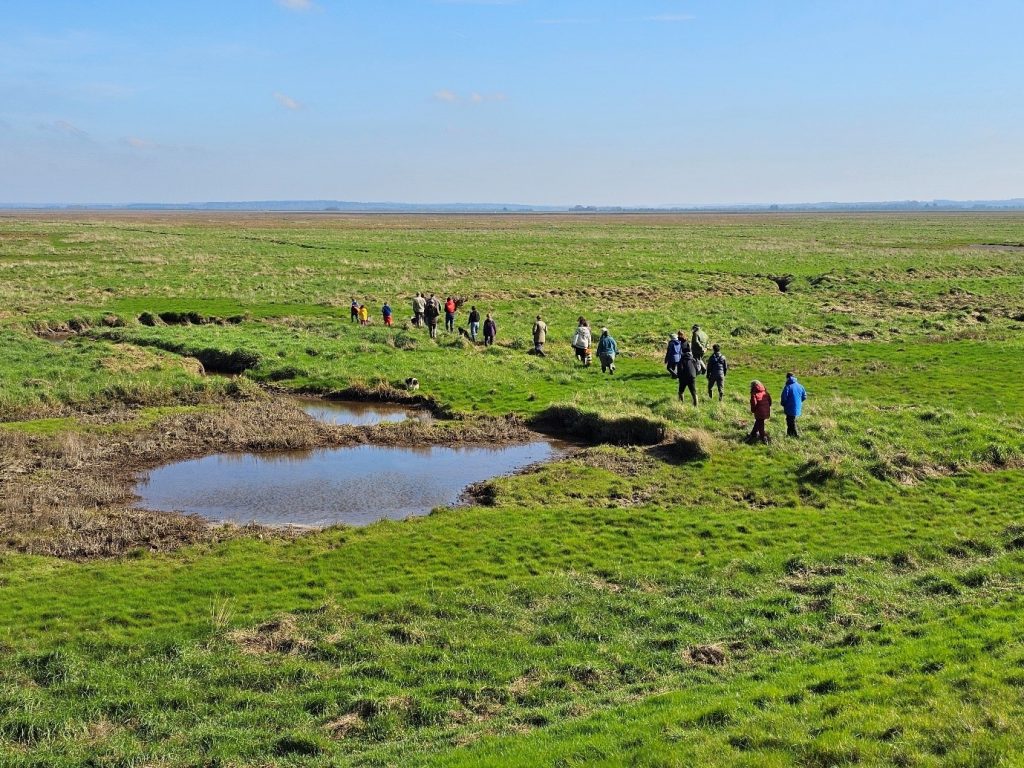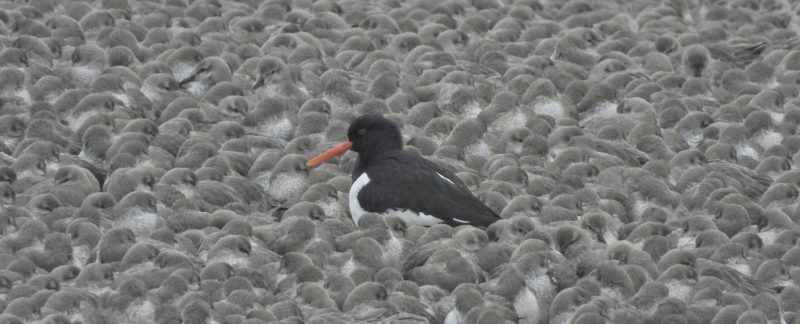Friday 8 March – The Maltings, Ely
Members of WWRG formed a large proportion of over 150 people who gathered at The Maltings, Ely, to celebrate the life of Mark Smart who died suddenly in February at the age of just 56. Mark’s family dressed the tables with mementos of Mark’s wide-ranging talents and interests and five speakers built a vivid picture of his life. Mark grew up in farming with huge enthusiasm for agricultural machinery. Decades of involvement with WWRG and a deep interest in the science of waders then gave Mark a unique combination of skills. Working for the RSPB, he demonstrated practically how big machinery can transform habitats and hence the fortunes of breeding waders. Several RSPB reserves (and other reserves) including Berney Marshes and Crook of Baldoon will form his wider legacy while we in WWRG miss his friendship and commitment as Membership Secretary and Vice-Chair of the WWRG Trustees.
Mark’s dedication to WWRG was further reflected in his family’s decision to scatter his ashes at Terrington Marsh the next morning. The simple but moving ceremony out on the sunlit marsh enabled us to reflect individually and collectively upon a friend who has done so much to help secure a future for wading birds.

Friday 8 March
Recce at Heacham South
Hilary travelled to Snettisham arriving at 13:45. She walked northwards passing c. 300 Oystercatcher and c. 200 Knot on the mussel scar off Snettisham Dam. A further c. 300 Oystercatcher were scattered all along the mudflats below Heacham beach, but small groups kept flying off to the south, possibly in response to several dog walkers. By 14:41 when Hilary reached the ‘Tump’ most Oystercatchers had left, leaving a flock of 42 which came onto the beach to roost. However, at 14:50 dog disturbance caused most of the flock to fly southwards, leaving only 12 roosting on the beach. Despite a further episode of disturbance, these 12 Oystercatchers remained close to the ‘Tump’ until at least 15:25. The flock was too small to justify an afternoon catching attempt on Saturday.
Recce at Terrington Marsh
Lizzie, Nigel, Cathy and Lys went to the White Barn at Terrington Marsh at 17:30 to check water levels on the marsh shortly after high tide. They found water in the inner pool and plenty of birds on the marsh behind. There was some concern about the wind, forecast to be a 13 mph easterly, gusting to 25 mph, throughout the night. As tidal conditions were benign with no surge likely, Nigel considered that the moderate breeze was just acceptable for mist netting.
Saturday 9 March
Mist netting at Terrington Marsh
High tide at 05:43 meant an unusually early departure from base at 00:45. Though breezy, as forecast, conditions were good. It was overcast but dry, with a temperature of 7oC.
Seven nets were set in lines of five and two on each side of the inner pool. This was not quite to plan, due to the two bags of nets being confused with bird bags and left behind necessitating a rapid trip back to the barn by Lizzie and Molly to collect them. Sound lures were used and a steady rate of catching achieved. The bird bags were carried back to the White Barn in two batches using a pole. All Knot and Bar-tailed Godwit were flagged.

Catching at night gave the benefit of daylight for much of the processing and later the work moved out into the sunshine. We were joined by one of our Honorary President Daphne Watson and long-standing WWRG member, Pete Potts.
Ringing totals
| Species | New | Retrap | Total |
| Oystercatcher | 9 | – | 9 |
| Bar-tailed Godwit | 3 | – | 3 |
| Turnstone | 1 | 2 | 3 |
| Knot | 86 | 5 | 91 |
| Dunlin | 55 | 2 | 57 |
| Redshank | 3 | 1 | 4 |
| Totals | 157 | 10 | 167 |
Upon the team’s return to the base, breakfast was eaten somewhat hastily as Mark Smart’s family and close friends gathered in readiness for the scattering of his ashes back at Terrington Marsh. Further socialisation between long-standing friends continued into the early afternoon, by which time many of the mist-netting team, who had been up most of the night, needed a nap.
Recce at Heacham South
Lucy and James repeated Friday’s recce of the southern end of Heacham Beach at the 05:43 High Tide which coincided with first daylight. They found 300–400 Oystercatcher so decided that attempting a catch at dawn on Sunday would be worthwhile since the risk of disturbance was low.
After dark on Saturday evening, about 20:00, three nets were set close to the Tump at Heacham South. As the tide was predicted to be 0.24 feet higher on Sunday morning than Saturday evening, the nets were set five feet higher up the beach than the Saturday evening tideline. Large-mesh nets were chosen because the offshore breeze was still significant.
Sunday 10 March
Cannon netting at Heacham South
On arrival, most of the team hid behind the dunes after Kate and David were sent off as long-stops. Lizzie and Lucy watched the nets where, initially, there appeared to be potential for a large catch of Oystercatcher. However, in the gloomy conditions, they had difficulty seeing where birds were in relation to the nets. When Rob cautiously looked over the dune to assist, most of the birds flew. The decoys were put out hastily, about 25 Oystercatcher returned and the catch taken.
During processing, the weights of the birds were found to be c. 50 g lighter than the long-term average for March, a cause for concern. There were good opportunities for training with duplicate measurements of bill and wing lengths being made. Despite its modest size, this was the largest catch of Oystercatcher achieved during the 2023/24 winter.
Ringing Totals
| Species | New | Retrap | Total |
| Oystercatcher | 18 | 3 | 21 |
| Turnstone | 1 | – | 1 |
| Totals | 19 | 3 | 22 |
Trip Ringing Totals
| Species | New | Retrap | Total |
| Oystercatcher | 27 | 3 | 30 |
| Bar-tailed Godwit | 3 | – | 3 |
| Turnstone | 2 | 2 | 4 |
| Knot | 86 | 5 | 91 |
| Dunlin | 55 | 2 | 57 |
| Redshank | 3 | 1 | 4 |
| Totals | 176 | 13 | 189 |
Resighting Report (by Carole Davis)
Carole Davis and Bernard Siddle masterminded three days of resighting, taking advantage of the high tides following on from the WWRG weekend.
| Species | WWRG (Individuals) | Non-WWRG (individuals) | Total |
| Curlew | 10 | 3 | 13 |
| Bar-tailed Godwit | 23 | 0 | 23 |
| Knot | 29 | 12 | 41 |
| Turnstone | 1 | 0 | 1 |
| Total | 63 | 15 | 78 |
The non-WWRG Curlew were all headstarted birds seen in a flock of Curlew feeding over high tide on one of the Wild Ken Hill fields at Heacham South.
The Bar-tailed Godwit were all seen on Snettisham beach on the falling tide on Saturday. No birds appeared on a second attempt on Monday, probably due to the presence of large machinery moving the sand on the beach. Two of the Bar-tailed Godwit were ringed in 2018 and have not been seen since.
The Knot were all sighted on Snettisham pits on 11–13 March when the tide was high enough to push large numbers off the mudflats. The non-WWRG Knot comprised:
- Four ringed in SW Iceland, all in May 2023.
- One ringed in NW England in 2021 was subsequently caught on The Wash and has also been resighted previously.
- Four ringed in Scotland in 2021/2022 (three on the Moray Firth in winter and one in Orkney on spring passage) and all seen previously on The Wash.
- Three ringed in The Netherlands, one in 2010 and seen previously on The Wash.
Of the 29 WWRG Knot, 24 were from the three catches over the winter of 2023/24. Five were from earlier catches of which three will have been up to the High Arctic breeding grounds at least once since the date of ringing (see table below).

| Date of catch | WWRG Knot resighted (individuals) |
| 9 March 2024 | 9 |
| 13 January 2024 | 5 |
| 16 December 2023 | 10 |
| 5 August 2023 | 1 |
| 11 March 2023 | 1 |
| 11 September 2022 | 1 |
| 7 November 2021 | 1 |
| 10 October 2021 | 1 |
| Total | 29 |
Thanks to Hilary Hodkinson and Carole Davis for writing this report. Cover image by Cathy Ryden.

